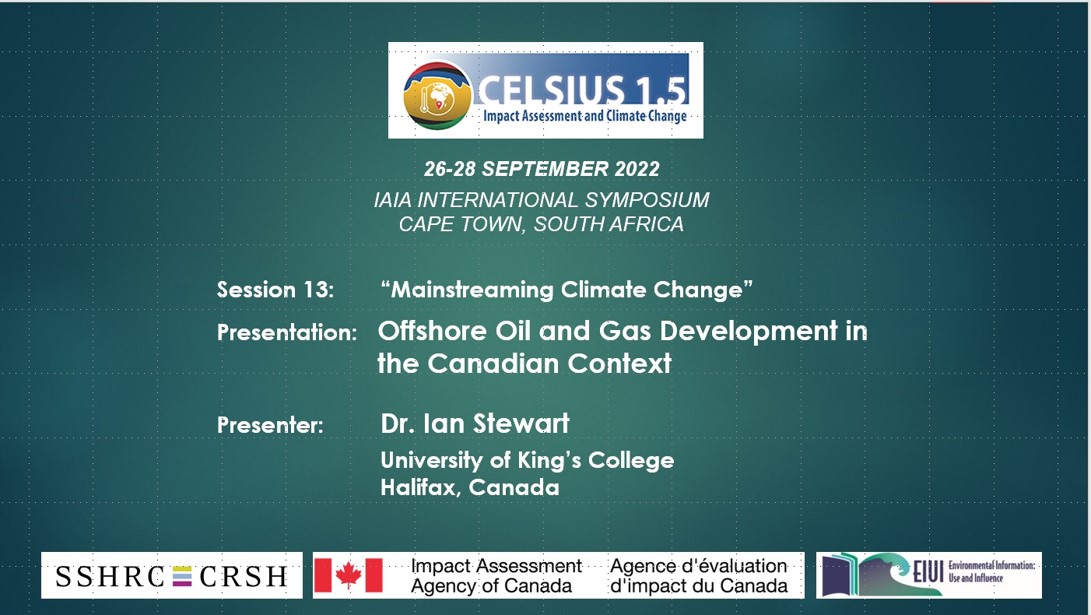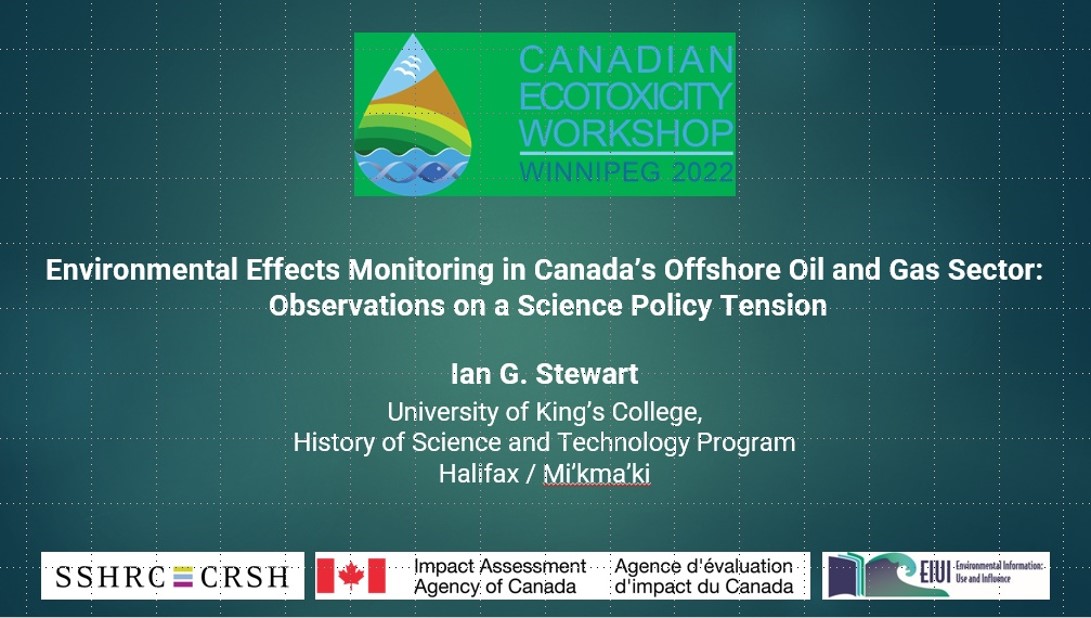Early Fall 2022 was a busy time for me as it involved two online conference presentations. First up was the Celsius 1.5: Impact Assessment and Climate Change conference of the South Africa chapter of International Association for Impact Assessment (IAIA) in Cape Town, 26-28 September 2022. Following on new connections made at the IAIA conference in Vancouver in May 2022 (described in a previous EIUI blog post), I was invited to join an online panel in Cape Town that included two new contacts, Bayo Majekolagbe, an impact assessment specialist from Nigeria (and a PhD candidate at the Shulich School of Law, Dalhousie University), and Rodrigo Suárez Castaño, Director General of the National Authority for Environmental Licencing for Columbia. This panel compared both high level policies (in light of national commitments) and practical applications of impact assessments across a range of natural resource extraction projects, with a view to determine how they considered climate change. Because of the distributed nature (both in time and place) of climate change effects, conducting impact assessments is a tough challenge with respect to climate change because so much of the assessment methodology is designed for geographically specific projects. Our panel contributed to the conference sub theme “Climate Change and Impact Assessment,” and was dedicated to the late Dr. Meinhard Doelle, a dear friend and colleague at Dalhousie University, whose life was sadly cut short on the 17 September 2022. He led the field of impact assessment scholarship on this topic.
My paper reflected on recent impact assessment practice in Newfoundland and Labrador for the offshore oil and gas sector, and the challenges facing such sectors in terms of how to “mitigate” climate change impacts when the industry itself is, by most accounts, at the heart of the problem. The relevance of this challenge to environmental information management includes the question of how to “measure” climate change impacts of offshore oil and gas projects: do we do this just by measuring emissions at production (scope 1 and scope 2 emissions), or do we include the impacts of CO2 release of “scope 3” emissions as well, which deal with the emissions due to the full “value chain” of a hydrocarbon production. These are more complex and harder to track, though still part of the story of “impact,” as they can include such emissions as are caused by the transportation, management, and eventual use of hydrocarbones (e.g., emissions from the tailpipes of hydrocarbon-powered vehicles and power plants). In addition, what role will promised “carbon capture and storage” plans play in measurements of impacts? Nothing is trivial here, especially when, at least for the current government of Newfoundland and Labrador, there is no interest in “keeping oil and gas in the ground” for economic reasons.
The second conference was an appearance (albeit online) at the 48th Annual Canadian Ecotoxicity Workshop (CEW), held in Winnipeg, 2-5 October 2022. My paper (pre-recorded for online delivery) was part of a panel on 30 years of environmental effects monitoring led by a giant in the Canadian context of such monitoring, Kelly Munkittrick, University of Calgary. It was a treat to be part of this event for several reasons, one of which was that I was able to refer to the work of an EIUI colleague Peter Wells, who was awarded the Outstanding Contribution and Service Award at the 2021 conference. My paper, “Environmental effects monitoring in Canada’s offshore oil and gas sector: Observations on a science policy tension,” gave a brief history of the gradual application of, and consequences of, environmental effects techniques from other sectors (e.g., pulp and paper, and mining) to management of offshore oil and gas development in Atlantic Canada. My sources drew heavily on Peter’s work, and of others he had directed me to (or even lent to me!) to prepare this presentation. The “tension” that I outlined in my paper is of central interest to EIUI, namely, how to integrate information from different sources, geographies, and time scales, about hugely challenging and dynamic ecosystems, before, during, and after a project is complete. These conditions are especially challenging when “baselines” are hard to come by, and where integration of information between private sector players, regulators, and government science experts (e.g., Fisheries and Oceans Canada and Environment and Climate Change Canada) is not always so easily established. The very success of ecotoxicity methods, allowing them to be increasingly taken up in environmental effects monitoring sytems with increasing accuracy, can offer the appearance of certainty about impacts on ecosystems, when in reality much is still unknown, partly because of the challenges of integration. This state is something we have come to understand as the simultaneously technical (scientific) and human dimensions of “barriers and enablers” of successful environmental information management. Peter’s work, going back almost 20 years, anticipated much of this already! Thanks Peter!
 “Offshore Oil and Gas Development in the Canadian Context” (Celcius 1.5: Impact Assessment and Climate Change, Cape Town, South Africa)
“Offshore Oil and Gas Development in the Canadian Context” (Celcius 1.5: Impact Assessment and Climate Change, Cape Town, South Africa)
Abstract: Recent scholarship on climate change (CC) and impact assessment (IA) has identified four key characteristics of climate change that must be centred in IA theory and practice. This presentation reflects on recent Canadian experience to address two of these from the perspective of how IA is currently theorized and conduced in the offshore oil and gas (O&G) sector. First, the global and multi-sectoral nature of emissions sources means IA for the O&G sector must consider not just scope 1 or 2 emissions, but also scope 3, which is a significant challenge given the complexity of post-production supply chain management. Second, the need for adaptation and compensation regimes for offshore oil and gas in particular has been challenging to implement, given the difficulties of local populations to access such means of address. Their livelihoods often experience both the impacts of CC most directly, and are also disproportionately impacted by accidents (e.g., oil spills) from offshore O&G developments. Planning for such accidents constitutes a significant aspect of IAs for this sector. This paper makes some suggestions based on recent Canadian experience that may stimulate dialogue at this conference in light of growing South African interest in expanding offshore operations.
 “Environmental Effects Monitoring in Canada’s Offshore Oil and Gas Sector: Observations on a Science Policy Tension” (48th Annual Canadian Ecotoxicity Workshop, Winnipeg, Canada)
“Environmental Effects Monitoring in Canada’s Offshore Oil and Gas Sector: Observations on a Science Policy Tension” (48th Annual Canadian Ecotoxicity Workshop, Winnipeg, Canada)
Abstract: Environmental effects management (EEM) connected to offshore oil and gas development has been in effect for over two decades in Canada’s Atlantic waters, being integrated into Canada’s impact assessment (IA) legal frameworks and regulatory oversight mechanisms. Methods for monitoring, in particular the ecotoxicological effects of hydrocarbons and other potential pollutants related to routine operations, have evolved, punctuated also by intense periods of research on accidental oil spills following disasters such as the Deepwater Horizon tragedy in the Gulf of Mexico in 2010. This paper briefly surveys that history, and then describes a present day science-policy tension. On the one hand, as a review of EEM reports and IA documents associated with offshore development projects makes clear, after so many years EEM appears to be confident of itself, contributing to what appears to be a trend towards relaxing the IA regime for Canada’s offshore. On the other hand, concerns about our abilities to monitor and thus understand the toxicological effects of routine operations on the ecotoxicology of fish and fish habitat features centrally in the record of community concerns about offshore development, including Indigenous communities in Newfoundland and Labrador and Nova Scotia. The concerns only increase with respect to effects of major spills due to accidental releases from wellheads or transport. This presentation concludes with some science-policy considerations regarding the continued role that Canada’s ecotoxicology community can play to address this tension, and as Newfoundland and Labrador seeks to expand its offshore hydrocarbon development.
Author: Ian Stewart
